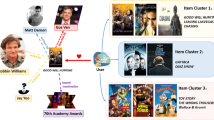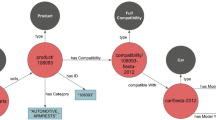Abstract
Faced with the challenges of intelligently managing the entire product lifecycle, traditional management techniques no longer meet the complex demands of modern enterprises. To address it, we employ an ontology modeling method based on a multidimensional view of product information for a knowledge graph, culminating in a comprehensive PLM knowledge system. To better serve PLM users, we propose an intelligent recommendation model based on context and user behavior for knowledge recommendations. This model seamlessly integrates the knowledge storage structure, user preference attributes, and the rich semantics of the knowledge graph. To improve the recommendation capability of the model, we design an improved multi-hop neighbor node sampling algorithm and use a graph convolutional neural network to quantify the target user preference attributes layer by layer. After a series of rigorous validation experiments, our method consistently outperformed competing models across key performance metrics, such as accuracy and recall, underscoring its efficacy and practicality in knowledge recommendation within PLM systems.












Similar content being viewed by others
Data availability
The data used in this study are generated by the author’s independent experiment.
References
Alkahtani M, Choudhary A, De A, Harding JA (2019) A decision support system based on ontology and data mining to improve design using warranty data. Comput Ind Eng 128:1027–1039
Chungoora N, Young RI, Gunendran G, Palmer C, Usman Z, Anjum NA, Cutting-Decelle A-F, Harding JA, Case K (2013) A model-driven ontology approach for manufacturing system interoperability and knowledge sharing. Comput Ind 64(4):392–401
Cui Z, Xu X, Fei X, Cai X, Cao Y, Zhang W, Chen J (2020) Personalized recommendation system based on collaborative filtering for iot scenarios. IEEE Trans Serv Comput 13(4):685–695
D’Angelo G, Palmieri F (2023) A co-evolutionary genetic algorithm for robust and balanced controller placement in software-defined networks. J Netw Comput Appl 212:103583
D’Angelo G, Della-Morte D, Pastore D, Donadel G, De Stefano A, Palmieri F (2023) Identifying patterns in multiple biomarkers to diagnose diabetic foot using an explainable genetic programming-based approach. Future Gener Comput Syst 140:138–150
Deepa N, Pandiaraja P (2020) Hybrid context aware recommendation system for e-health care by Merkle hash tree from cloud using evolutionary algorithm. Soft Comput 24(10):7149–7161
He X, Deng K, Wang X, Li Y, Zhang Y, Wang M (2020) Lightgcn: Simplifying and powering graph convolution network for recommendation. In: Proceedings of the 43rd International ACM SIGIR Conference on Research and Development in Information Retrieval. pp 639–648
Hernández-Nieves E, Hernández G, Gil-González A-B, Rodríguez-González S, Corchado JM (2020) Fog computing architecture for personalized recommendation of banking products. Expert Syst Appl 140:112900
Hou X, Wang X (2019) Modeling and representation of intangible cultural heritage knowledge using linked data and ontology. Proc Assoc Inf Sci Technol 56(1):409–412
Hu S, Zou L, Yu JX, Wang H, Zhao D (2017) Answering natural language questions by subgraph matching over knowledge graphs. IEEE Trans Knowl Data Eng 30(5):824–837
Kashani SMZ, Hamidzadeh J (2020) Feature selection by using privacy-preserving of recommendation systems based on collaborative filtering and mutual trust in social networks. Soft Comput 24(15):11425–11440
Kong T, Hu T, Zhou T, Ye Y (2021) Data construction method for the applications of workshop digital twin system. J Manuf Syst 58:323–328
Lim KYH, Zheng P, Chen C-H (2020) A state-of-the-art survey of digital twin: techniques, engineering product lifecycle management and business innovation perspectives. J Intell Manuf 31(6):1313–1337
Liu Z, Wang L, Li X, Pang S (2021) A multi-attribute personalized recommendation method for manufacturing service composition with combining collaborative filtering and genetic algorithm. J Manuf Syst 58:348–364
Luo C, Pang W, Wang Z, Lin C (2014) Hete-cf: Social-based collaborative filtering recommendation using heterogeneous relations. In: 2014 IEEE International Conference on Data Mining. IEEE. pp 917–922
Medina-Barbosa DA, Siller HR (2013) Product lifecycle management model for new technology based enterprises. In: International Conference on Cooperative Design, Visualization and Engineering. Springer. pp 93–100
Ni J, Li J, McAuley J (2019) Justifying recommendations using distantly-labeled reviews and fine-grained aspects. In: Proceedings of the 2019 Conference on Empirical Methods in Natural Language Processing and the 9th International Joint Conference on Natural Language Processing (EMNLP-IJCNLP). pp 188– 197
Pereira R, Lopes H, Breitman K, Mundim V, Peixoto W (2014) Cloud based real-time collaborative filtering for item-item recommendations. Comput Ind 65(2):279–290
Rendle S (2012) Factorization machines with libfm. ACM Trans Intell Syst Technol (TIST) 3(3):1–22
Shi C, Zhang Z, Luo P, Yu PS, Yue Y, Wu B (2015) Semantic path based personalized recommendation on weighted heterogeneous information networks. In: Proceedings of the 24th ACM International on Conference on Information and Knowledge Management. pp 453–462
Smirnov A, Shilov N (2013) Ontology matching in collaborative recommendation system for plm. Int J Prod Lifecycle Manag 6(4):322–338
Tang X, Wang T, Yang H, Song H (2019) Akupm: Attention-enhanced knowledge-aware user preference model for recommendation. In: Proceedings of the 25th ACM SIGKDD International Conference on Knowledge Discovery & Data Mining. pp 1891–1899
Vila C, Ugarte D, Ríos J, Abellán J (2017) Project-based collaborative engineering learning to develop industry 4.0 skills within a plm framework. Proc Manuf 13:1269–1276
Wang H, Zhang F, Wang J, Zhao M, Li W, Xie X, Guo M (2018a) Ripplenet: Propagating user preferences on the knowledge graph for recommender systems. In: Proceedings of the 27th ACM International Conference on Information and Knowledge Management. pp 417–426
Wang H, Zhang F, Xie X, Guo M (2018b) Dkn: Deep knowledge-aware network for news recommendation. In: Proceedings of the 2018 World Wide Web Conference, pp 1835–1844
Wang X, He X, Cao Y, Liu M, Chua T-S (2019a) Kgat: Knowledge graph attention network for recommendation. In: Proceedings of the 25th ACM SIGKDD International Conference on Knowledge Discovery & Data Mining. pp 950–958
Wang H, Zhao M, Xie X, Li W, Guo M (2019b) Knowledge graph convolutional networks for recommender systems. In: The World Wide Web Conference. pp 3307–3313
Wei Y, Wang X, Nie L, He X, Hong R, Chua T-S (2019) Mmgcn: Multi-modal graph convolution network for personalized recommendation of micro-video. In: Proceedings of the 27th ACM International Conference on Multimedia. pp 1437–1445
Xu Z, Dang Y (2021) Solution knowledge mining and recommendation for quality problem-solving. Comput Ind Eng 159:107313
Yan D, Cao H, Wang T, Chen R, Xue S (2021) Graph-based knowledge acquisition with convolutional networks for distribution network patrol robots. IEEE Trans Artif Intell 2(5):384–393
Yuan W, Wang H, Yu X, Liu N, Li Z (2020) Attention-based context-aware sequential recommendation model. Inf Sci 510:122–134
Yu X, Ren X, Sun Y, Gu Q, Sturt B, Khandelwal U, Norick B, Han J (2014) Personalized entity recommendation: a heterogeneous information network approach. In: Proceedings of the 7th ACM International Conference on Web Search and Data Mining, pp 283–292
Zhang XA, Li JX, Cui HF (2014) Research of active knowledge aided system in the bearing design. Appl Mech Mater 496:2320–2323
Zhang F, Yuan NJ, Lian D, Xie X, Ma W-Y (2016) Collaborative knowledge base embedding for recommender systems. In: Proceedings of the 22nd ACM SIGKDD International Conference on Knowledge Discovery and Data Mining, pp. 353–362
Zhang L, Tan R, Peng Q, Shao P, Dong Y, Wang K (2022) Construction and application of enterprise knowledge base for product innovation design. Appl Sci 12(13):6358
Zhao J, Zhou Z, Guan Z, Zhao W, Ning W, Qiu G, He X (2019) Intentgc: a scalable graph convolution framework fusing heterogeneous information for recommendation. In: Proceedings of the 25th ACM SIGKDD International Conference on Knowledge Discovery & Data Mining. pp 2347–2357
Zheng P, Xia L, Li C, Li X, Liu B (2021) Towards self-x cognitive manufacturing network: an industrial knowledge graph-based multi-agent reinforcement learning approach. J Manuf Syst 61:16–26
Zhou X, Li Y, Liang W (2020) Cnn-rnn based intelligent recommendation for online medical pre-diagnosis support. IEEE/ACM Trans Comput Biol Bioinform 18(3):912–921
Acknowledgements
This work was supported by the National Key Research and Development Program of China under Grant No. 2018YFB1700902.
Funding
The authors have not disclosed any funding.
Author information
Authors and Affiliations
Contributions
GT, DL, XL: conceptualization, methodology, Validation, Investigation, Resources, Data curation, Writing - original draft, Writing - review & editing, Visualization, Supervision, Project administration.
Corresponding author
Ethics declarations
Conflict of interest
The authors declare that they have no known competing financial interests or personal relationships that could have appeared to influence the work reported in this paper.
Ethical approval
This article does not contain any studies with human participants performed by any of the authors.
Additional information
Publisher's Note
Springer Nature remains neutral with regard to jurisdictional claims in published maps and institutional affiliations.
Rights and permissions
Springer Nature or its licensor (e.g. a society or other partner) holds exclusive rights to this article under a publishing agreement with the author(s) or other rightsholder(s); author self-archiving of the accepted manuscript version of this article is solely governed by the terms of such publishing agreement and applicable law.
About this article
Cite this article
Tong, G., Li, D. & Liu, X. An improved model combining knowledge graph and GCN for PLM knowledge recommendation. Soft Comput 28, 5557–5575 (2024). https://doi.org/10.1007/s00500-023-09340-0
Accepted:
Published:
Issue Date:
DOI: https://doi.org/10.1007/s00500-023-09340-0




